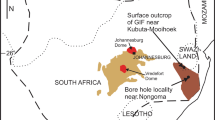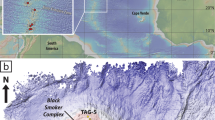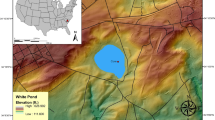Abstract
Rapidly deposited sediments from marine and lake environments are being used increasingly to study decadal to millennial fluctuations in the Earth's magnetic field. The objectives are to gain more fundamental understanding of the geodynamo and to establish a new dating technique for sediments. While lacustrine sections are generally restricted to temperate latitude glacial lakes (≤ 20,000 yr old), rapidly deposited marine sediments along continental margins potentially offer continuous high resolution, yet long-term records of geomagnetic secular variation. However, to interpret the sedimentary magnetic record accurately, geochemical processes that affect the reliability of the magnetic signal must be understood. We now report downcore magnetic profiles from undisturbed Kasten cores taken in rapidly deposited laminated sediments from the Gulf of California and in bioturbated haemipelagic muds on the Oregon continental slope which give apparently reliable directions, but show dramatic decreases in the intensities of natural (NRM) and artificial (ARM, IRM) remanences with depth. Downcore porewater and solid sulphur analyses show concave-down decreases in porewater sulphate and systematic increases in pyrite and metastable monosulphides. The maximum curvature of the sulphide profile occurs directly below the high magnetization zone. Combined with other compositional and mineralogical analyses, these data suggest that due to oxidative decomposition of organic matter, magnetites and other iron oxides become progressively reduced and subsequently sulphidized and pyritized with depth. Iron reduction seems to occur before sulphide formation. Changes in magnetic stability parameters are consistent with selective dissolution of the finer-sized grains causing downcore coarsening of the magnetic fraction.
This is a preview of subscription content, access via your institution
Access options
Subscribe to this journal
Receive 51 print issues and online access
$199.00 per year
only $3.90 per issue
Buy this article
- Purchase on Springer Link
- Instant access to full article PDF
Prices may be subject to local taxes which are calculated during checkout
Similar content being viewed by others
References
Stumm, W. & Morgan, J. J. Aquatic Chemistry (Wiley, New York, 1970).
Reeburgh, W. S. A. Rev. Earth planet. Sci. 11, (in the press).
Froelich, P. N. et al. Geochim. cosmochim. Acta 43, 1075–1090 (1979).
Berner, R. A. J. Geol. 72, 293–306 (1964).
Rickard, D. T. Am. J. Sci. 275, 636–652 (1975).
Goldhaber, M. B. & Kaplan, I. R. in The Sea Vol. 5 (ed. Goldberg, E. D.) 569–655 (Wiley, New York, 1974).
Berner, R. A. Early Diagenesis, A Theoretical Approach (Princeton University Press, 1980).
Berner, R. A. Am. J. Sci. 268, 1–23 (1970).
Henshaw, P. C. Jr & Merrill, R. T. Rev. Geophys. Space Phys. 18, 483–504 (1980).
Heath, G. R., Moore, T. C. & Dauphin, J. P. in The Fate of Fossil Fuel Carbon Dioxide (eds Anderson, N. & Malahoff, A.) (Plenum, New York, 1977).
Sayles, F. L. & Manheim, F. T. Geochim. cosmochim. Acta 39, 103–128 (1975).
Dunlop, D. J. Geophys. J. R. astr. Soc. 27, 37–55 (1972).
Levi, S. & Merrill, R. T. Earth planet. Sci. Lett. 32, 171–184 (1976).
Sorensen, J., Appl. envir. Microbiol. 43, No. 2, 319–324 (1982).
Berner, R. A. Fortschr. Miner. 59, 1, 117–135 (1981).
Levi, S. & Banerjee, S. K. Earth planet. Sci. Lett. 29, 219–226 (1976).
Author information
Authors and Affiliations
Rights and permissions
About this article
Cite this article
Karlin, R., Levi, S. Diagenesis of magnetic minerals in Recent haemipelagic sediments. Nature 303, 327–330 (1983). https://doi.org/10.1038/303327a0
Received:
Accepted:
Issue Date:
DOI: https://doi.org/10.1038/303327a0
This article is cited by
-
Reductive dissolution of biogenic magnetite
Earth, Planets and Space (2020)
-
Magnetic mineral diagenesis in sediments of saline lake Lop Nur
Journal of Mountain Science (2019)
-
Magnetic mineral diagenesis in anoxic laminated sediments from the Southern Gulf of California
Studia Geophysica et Geodaetica (2018)
-
Recent Applications of Mineral Magnetic Methods in Sediment Pollution Studies: a Review
Current Pollution Reports (2018)
-
Comparative study on magnetic minerals of tidal flat deposits from different sediment sources in Jiangsu coast, Eastern China
Studia Geophysica et Geodaetica (2017)
Comments
By submitting a comment you agree to abide by our Terms and Community Guidelines. If you find something abusive or that does not comply with our terms or guidelines please flag it as inappropriate.



